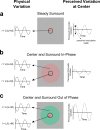Separating monocular and binocular neural mechanisms mediating chromatic contextual interactions
- PMID: 24744449
- PMCID: PMC3993201
- DOI: 10.1167/14.4.13
Separating monocular and binocular neural mechanisms mediating chromatic contextual interactions
Abstract
When seen in isolation, a light that varies in chromaticity over time is perceived to oscillate in color. Perception of that same time-varying light may be altered by a surrounding light that is also temporally varying in chromaticity. The neural mechanisms that mediate these contextual interactions are the focus of this article. Observers viewed a central test stimulus that varied in chromaticity over time within a larger surround that also varied in chromaticity at the same temporal frequency. Center and surround were presented either to the same eye (monocular condition) or to opposite eyes (dichoptic condition) at the same frequency (3.125, 6.25, or 9.375 Hz). Relative phase between center and surround modulation was varied. In both the monocular and dichoptic conditions, the perceived modulation depth of the central light depended on the relative phase of the surround. A simple model implementing a linear combination of center and surround modulation fit the measurements well. At the lowest temporal frequency (3.125 Hz), the surround's influence was virtually identical for monocular and dichoptic conditions, suggesting that at this frequency, the surround's influence is mediated primarily by a binocular neural mechanism. At higher frequencies, the surround's influence was greater for the monocular condition than for the dichoptic condition, and this difference increased with temporal frequency. Our findings show that two separate neural mechanisms mediate chromatic contextual interactions: one binocular and dominant at lower temporal frequencies and the other monocular and dominant at higher frequencies (6-10 Hz).
Keywords: color appearance/constancy; contextual interactions; temporal modulation.
Figures






Similar articles
-
A central mechanism of chromatic contrast.Vision Res. 2000;40(23):3173-80. doi: 10.1016/s0042-6989(00)00167-x. Vision Res. 2000. PMID: 11008136
-
Differentiation of VEP intermodulation and second harmonic components by dichoptic, monocular, and binocular stimulation.Vis Neurosci. 1996 Nov-Dec;13(6):1157-66. doi: 10.1017/s0952523800007793. Vis Neurosci. 1996. PMID: 8961544
-
Dichoptic perception of brown.J Opt Soc Am A Opt Image Sci Vis. 2016 Mar;33(3):A123-8. doi: 10.1364/JOSAA.33.00A123. J Opt Soc Am A Opt Image Sci Vis. 2016. PMID: 26974916
-
The dynamics of cross-orientation masking at monocular and interocular sites.Vision Res. 2015 Nov;116(Pt A):80-91. doi: 10.1016/j.visres.2015.09.008. Vision Res. 2015. PMID: 26452719
-
Temporal dependencies in resolving monocular and binocular cue conflict in slant perception.Vision Res. 2000;40(14):1869-85. doi: 10.1016/s0042-6989(00)00034-1. Vision Res. 2000. PMID: 10837832
References
-
- Autrusseau F., Shevell S. K. (2006). Temporal nulling of induction from spatial patterns modulated in time. Visual Neuroscience , 23 (3-4), 479–482 - PubMed
-
- Barbur J. L., Spang K. (2008). Colour constancy and conscious perception of changes of illuminant. Neuropscyhologia , 46, 853–863 - PubMed
-
- Christiansen J. H., D'Antona A. D., Shevell S. K. (2009). The neural pathways mediating color shifts induced by temporally varying light. Journal of Vision , 9 (5): 13 1–10, http://www.journalofvision.org/content/9/5/26, doi:10.1167/9.5.26. [PubMed] [Article] - PMC - PubMed
-
- Conway B. R., Hubel D. H., Livingstone M. (2002). Color contrast in macaque V1. Cerebral Cortex , 12, 915–925 - PubMed
Publication types
MeSH terms
Grants and funding
LinkOut - more resources
Full Text Sources
Other Literature Sources

